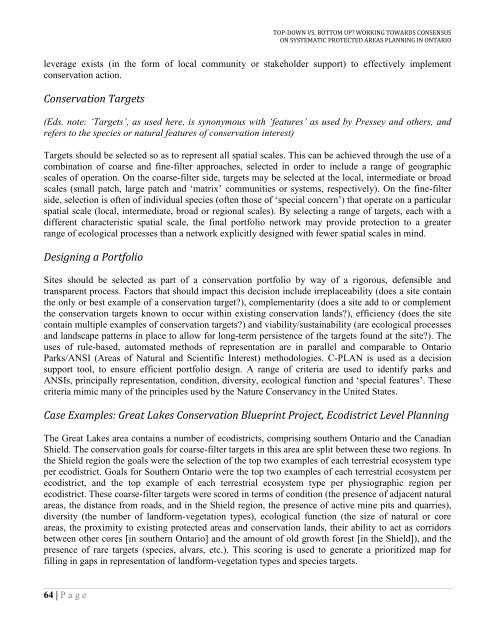Top-Down vs. Bottom Up: Working Towards Consensus ... - CASIOPA
Top-Down vs. Bottom Up: Working Towards Consensus ... - CASIOPA
Top-Down vs. Bottom Up: Working Towards Consensus ... - CASIOPA
- No tags were found...
You also want an ePaper? Increase the reach of your titles
YUMPU automatically turns print PDFs into web optimized ePapers that Google loves.
TOP-DOWN VS. BOTTOM UP? WORKING TOWARDS CONSENSUSON SYSTEMATIC PROTECTED AREAS PLANNING IN ONTARIOleverage exists (in the form of local community or stakeholder support) to effectively implementconservation action.Conservation Targets(Eds. note: „Targets‟, as used here, is synonymous with „features‟ as used by Pressey and others, andrefers to the species or natural features of conservation interest)Targets should be selected so as to represent all spatial scales. This can be achieved through the use of acombination of coarse and fine-filter approaches, selected in order to include a range of geographicscales of operation. On the coarse-filter side, targets may be selected at the local, intermediate or broadscales (small patch, large patch and „matrix‟ communities or systems, respectively). On the fine-filterside, selection is often of individual species (often those of „special concern‟) that operate on a particularspatial scale (local, intermediate, broad or regional scales). By selecting a range of targets, each with adifferent characteristic spatial scale, the final portfolio network may provide protection to a greaterrange of ecological processes than a network explicitly designed with fewer spatial scales in mind.Designing a PortfolioSites should be selected as part of a conservation portfolio by way of a rigorous, defensible andtransparent process. Factors that should impact this decision include irreplaceability (does a site containthe only or best example of a conservation target?), complementarity (does a site add to or complementthe conservation targets known to occur within existing conservation lands?), efficiency (does the sitecontain multiple examples of conservation targets?) and viability/sustainability (are ecological processesand landscape patterns in place to allow for long-term persistence of the targets found at the site?). Theuses of rule-based, automated methods of representation are in parallel and comparable to OntarioParks/ANSI (Areas of Natural and Scientific Interest) methodologies. C-PLAN is used as a decisionsupport tool, to ensure efficient portfolio design. A range of criteria are used to identify parks andANSIs, principally representation, condition, diversity, ecological function and „special features‟. Thesecriteria mimic many of the principles used by the Nature Conservancy in the United States.Case Examples: Great Lakes Conservation Blueprint Project, Ecodistrict Level PlanningThe Great Lakes area contains a number of ecodistricts, comprising southern Ontario and the CanadianShield. The conservation goals for coarse-filter targets in this area are split between these two regions. Inthe Shield region the goals were the selection of the top two examples of each terrestrial ecosystem typeper ecodistrict. Goals for Southern Ontario were the top two examples of each terrestrial ecosystem perecodistrict, and the top example of each terrestrial ecosystem type per physiographic region perecodistrict. These coarse-filter targets were scored in terms of condition (the presence of adjacent naturalareas, the distance from roads, and in the Shield region, the presence of active mine pits and quarries),diversity (the number of landform-vegetation types), ecological function (the size of natural or coreareas, the proximity to existing protected areas and conservation lands, their ability to act as corridorsbetween other cores [in southern Ontario] and the amount of old growth forest [in the Shield]), and thepresence of rare targets (species, alvars, etc.). This scoring is used to generate a prioritized map forfilling in gaps in representation of landform-vegetation types and species targets.64 | P a g e


